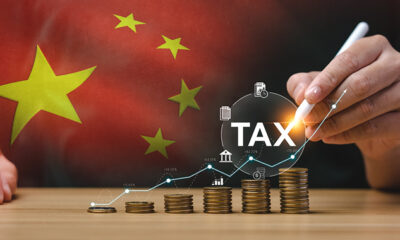China
Is Taiwan a country or not?

The UK referred to Taiwan as an “independent country” in a report, despite not officially recognizing Taiwan as a country.
Defining what is and isn’t a country is a lot more complicated than many people would realize. Take the case of Taiwan.
On Aug. 30, 2023, a committee of the U.K. Parliament referred to Taiwan as an “independent country” in a report. This is the first time any part of the British political system has used that phrasing.
Officially, the U.K. “does not recognise Taiwan” as a country, nor does it “maintain formal diplomatic relations with the island,” which is one way states recognize each other as equals on the international stage.
Like the U.K., the U.S. also “does not have diplomatic relations with Taiwan,” although there is a “robust unofficial relationship,” according to the State Department. Many other countries are in a similar boat.
So where does that leave Taiwan? Is it, or is it not, a country?
From my perspective as a political scientist, here’s how I would approach this question.
A country by declaration
According to what’s known as the “declarative theory of statehood,” a country – which is often referred to as a “state” in political science and international relations terminology – must possess the following qualities: “(a) a permanent population; (b) a defined territory; (c) government; and (d) capacity to enter into relations with the other states.”
These four qualities were agreed upon in the 1933 Montevideo Convention on the Rights and Duties of States, which is an international treaty registered with the League of Nations, the precursor to the United Nations.
Article 3 of that treaty says that the existence of a “state is independent of recognition by the other states.” In other words, as long as the four qualities above are met, an area qualifies as a country even if other countries choose not to recognize it.
One criticism of this framework is that it opens the door for many areas to be considered countries, even though they may seem outlandish.
For example, in the 1960s, Italian engineer Giorgio Rosa built a 4,000-square-foot (400-square-meter) platform 7 miles (11 kilometers) off the coast of Italy. On June 24, 1968, Rosa – whose last name means “rose” in English – declared that his platform was an independent country named the Republic of Rose Island. This artificial island had a restaurant, bar, souvenir shop and post office. Its official language was Esperanto.
It could be argued that Rose Island met the criteria outlined in the Montevideo Convention, as there was a permanent population because Rosa lived there; his humanmade platform had a defined territory; there was a government because Rosa declared himself president; and Rose Island’s post office gave it the capacity to communicate with, and thus enter into relations with, other countries.
Although several countries, including the U.S., have ratified the Montevideo Convention, Italy has not. So, 55 days after Rose Island declared independence, the Italian military destroyed the platform.
A country by recognition
In contrast to the declarative theory of statehood, what’s called the “constitutive theory of statehood” considers a country to be a country only if it is recognized by other already recognized countries.
There is no magic number for how many countries one must be recognized by. Rather, those that aspire to be regarded by the world as an independent country must join the United Nations as a full member.
In order to join the United Nations, applicants must be recommended by the Security Council, which comprises 15 members. Five of those members are permanent and have a veto. Applicants must have the support of nine of the 15 members, including each of the permanent members.
If the Security Council recommends admission, the application is presented to the General Assembly, where each full member of the United Nations has a single vote. A two-thirds majority is necessary before a country can join.
U.S. Rep. Rob Wittman, vice chairman of the House Armed Services Committee, met with Taiwan’s President Tsai Ing-wen, right, at the presidential office in Taipei, Taiwan, in September 2023.
Taiwan Presidential Office via AP
One China or two?
Today, most of the world’s countries officially adhere to some variation of the idea that there is only one China, whose capital is Beijing, and which encompasses both the mainland territory and the island of Taiwan.
There is a government there, but there is also a government on Taiwan, based in its capital, Taipei. That government calls itself the Republic of China and traces its history to the early 20th century, when a revolution overthrew the emperor of China.
Notably, at that time, nobody’s definition of China included the island of Taiwan, which was then commonly called Formosa. Japan had seized the island in a war in the late 19th century.
In 1927, an uprising by the Chinese Communist Party attacked the Republic of China government. That kicked off a bloody civil war that lasted until 1949.
In that year, the government of the Republic of China retreated to the island of Taiwan. That same year, Mao Zedong, leader of the Chinese Communist Party, proclaimed the founding of the People’s Republic of China, with its capital in Beijing.
But Mao still sought control over his enemy’s territory, declaring, “Taiwan is ours, and we will never compromise on this issue, which is an issue of internal affairs.”
To this day, the government of the People’s Republic of China, whose capital is Beijing, considers Taiwan part of its “sacred territory.” The constitution of the People’s Republic of China states that “(i)t is the lofty duty of the entire Chinese people, including our compatriots in Taiwan, to accomplish the great task of reunifying the motherland.” Its foreign affairs ministry says, “Taiwan is a sacred and inseparable part of China’s territory.” On Oct. 2, 2023, the Beijing government celebrated its national day by releasing a video signifying its focus on unity with the people of Taiwan.
In contrast, the Republic of China refers to the area under its control as “the Taiwan area,” or “the free area.” It refers to the rest of China as “the mainland area,” which the Taiwanese government has described as being under a “Period of Communist Rebellion.”
Other countries are similarly delicate. For example, in 1972, the U.S. “acknowledge(d) that all Chinese on either side of the Taiwan Strait maintain there is but one China and that Taiwan is a part of China.” In 1979, the U.S. again “acknowledge(d) the Chinese position that there is but one China and Taiwan is part of China.”
Taipei’s Mid-Autumn Festival drew crowds to the Night Market.
AP Photo/Chiang Ying-ying
Taiwan’s place in the world
Taiwan argues that it meets the Montevideo Convention’s criteria for being considered a country under the declarative theory of statehood. However, Taiwan has not yet formally declared itself to be a new, independent country. According to President Tsai Ing-wen, “(w)e don’t have a need to,” because “(w)e are an independent country already and we call ourselves the Republic of China.”
But recall that, according to the constitutive theory of statehood, a country is only a country if it’s recognized by other already recognized countries, and the ultimate manifestation of such recognition is full membership in the United Nations.
Interestingly, the Republic of China was actually a founding member of the United Nations. However, in 1971, the United Nations voted “to expel” the Republic of China, and instead recognized the Communist government “as the only legitimate representative of China to the United Nations.” Subsequent attempts by Taiwan to join the United Nations have been unsuccessful.
Today, only a dozen or so countries continue to maintain formal diplomatic ties with Taiwan, most of which are small island developing states such as Nauru, Palau and Tuvalu.
Each of these countries recognizes Taiwan as “the Republic of China,” and none of them simultaneously maintains offical ties with the People’s Republic of China.
Until Taiwan formally declares itself independent of the rest of China – or until Taiwan is recognized by the international community as being independent of the rest of China – Taiwan’s status as a country will continue to be questioned.
This article is republished from The Conversation under a Creative Commons license. Read the original article.
China
Revealing the Encouraged Industries of Hainan in 2024: Unlocking Opportunities

The 2024 Hainan Encouraged Catalogue, issued by the NDRC, MOF, and STA, aims to boost industries in the Hainan Free Trade Port. It prioritizes sectors like tourism, modern services, and high technologies, offering incentives for foreign investment and market access expansion since 2020. The Catalogue includes 176 entries across 14 categories, with 33 new additions focusing on cultural tourism, new energy, medicine and health, aviation, aerospace, and environmental protection.
The National Development and Reform Commission (NDRC), in collaboration with the Ministry of Finance (MOF) and the State Taxation Administration (STA), has issued the Catalogue of Industries Encouraged to Develop in Hainan Free Trade Port (2024 Version), hereinafter referred to as the “2024 Hainan Encouraged Catalogue.” The updated Catalogue took effect on March 1, 2024, replacing the previous 2020 Edition.
Beyond the industries already addressed in existing national catalogues, the new entries in the 2024 Hainan Encouraged Catalogue are based on practical implementation experiences and the specific needs within Hainan, prioritizing sectors such as tourism, modern services, and high technologies.
The Hainan FTP has been providing incentives to draw investors to invest and establish businesses in the region, especially foreign investment. Alongside a phased approach to opening the capital account and facilitating free capital movement, Hainan has significantly expanded market access for foreign enterprises since 2020, particularly in sectors such as telecommunications, tourism, and education.
The Hainan Encouraged Catalogue comprises two main sections:
Similar to the approach adopted by the western regions, foreign-invested enterprises (FIEs) should always implement their production or operations in accordance with the Catalogue of Encouraged Industries for Foreign Investment.
On top of the industries already addressed in existing national catalogues, the 2024 Hainan Encouraged Catalogue encompasses 14 distinct categories and a total of 176 entries especially encouraged in the region, including 33 new additions compared to the 2020 Edition. These new entries predominantly span cultural tourism, new energy, medicine and health, aviation and aerospace, and ecological and environmental protection, among others.
This article is republished from China Briefing. Read the rest of the original article.
China Briefing is written and produced by Dezan Shira & Associates. The practice assists foreign investors into China and has done since 1992 through offices in Beijing, Tianjin, Dalian, Qingdao, Shanghai, Hangzhou, Ningbo, Suzhou, Guangzhou, Dongguan, Zhongshan, Shenzhen, and Hong Kong. Please contact the firm for assistance in China at china@dezshira.com.
China
Key Guidelines for Companies in Compliance Audits for Personal Information Protection Standards

China’s standards authority has released draft standards for personal information protection compliance audits, potentially making them mandatory for companies in 2023. The audits will require companies to undergo annual or biennial checks based on the number of people’s information they handle. The draft standards outline the audit process and requirements, seeking public feedback until September 11, 2024.
China’s standards authority has released draft standards for conducting personal information protection compliance audits. Regular compliance audits to ensure compliance with personal information protection regulations may become a requirement for companies in China under draft measures released in 2023. We explain the audit processes and requirements proposed in the draft standards.
The Standardization Administration of China (SAC) has released a set of draft standards for conducting personal information (PI) protection compliance audits. Under draft measures released by the Cyberspace Administration of China (CAC) in August 2023, companies that process the PI of people in China are required to undergo regular compliance audits.
Specifically, companies that process the PI of over one million people must undergo a compliance audit at least once a year, while companies that process the PI of under one million people must carry out an audit at least once every two years.
While the draft measures stipulate the obligations of the auditing body and the audit scope, the draft standards outline the specific audit process, including evidence management and permissions of the audit organization, as well as the professional and ethical requirements of auditors.
The Secretariat of the National Cybersecurity Standardization Technical Committee is soliciting public feedback on the draft standards until September 11, 2024. Public comment on the draft measures released in August last year closed on September 2, 2023, but no updated document has yet been released.
The draft standards outline five stages of the PI protection compliance audit: audit preparation, implementation, reporting, problem rectification, and archiving management.
Auditors are required to accurately document identified security issues in the audit working papers, ensuring that the records are comprehensive, clear, and conclusive, reflecting the audit plan and its execution, as well as all relevant findings and recommendations.
This article is republished from China Briefing. Read the rest of the original article.
China Briefing is written and produced by Dezan Shira & Associates. The practice assists foreign investors into China and has done since 1992 through offices in Beijing, Tianjin, Dalian, Qingdao, Shanghai, Hangzhou, Ningbo, Suzhou, Guangzhou, Dongguan, Zhongshan, Shenzhen, and Hong Kong. Please contact the firm for assistance in China at china@dezshira.com.
China
A Comprehensive Guide to China’s Expanded 144-Hour Visa-Free Transit Policy at 37 Ports

China has expanded its 144-hour visa-free transit policy, allowing travelers from 54 countries to visit certain areas without a visa. Zhengzhou in Henan Province and eight cities in Yunnan Province are now included. The policy aims to promote people-to-people exchange and requires travelers to meet specific requirements.
China has expanded the 144-hour visa-free transit policy, which allows people from certain countries to enjoy six days of travel to select areas of the country without applying for a visa beforehand, to cover 54 countries and 37 ports. Zhengzhou in Henan Province and eight more cities in Yunnan Province can benefit from this policy as of July 15, 2024. Amid China’s continuous efforts to promote people-to-people exchange, we explain who is eligible for the 144-hour visa-free transit and where in China you can travel on this special entry permit.
The National Immigration Administration (NIA) has expanded China’s 144-hour visa-free transit policy to 37 ports as of July 15, 2024. Zhengzhou aviation port in Henan now offers this policy, with the stay limited to the administrative region of Henan Province. The stay range of Yunnan Province’s policy has been expanded from Kunming to eight other cities (prefecture-level) including Lijiang, Yuxi, Pu’er, Chuxiong, Dali, Xishuangbanna, Honghe, and Wenshan. Additionally, Zhengzhou Xinzheng International Airport, Lijiang Sanyi International Airport, and Mohan Railway Port have been added as ports applicable to the 144-hour visa-free transit policy.
In this article, we explain how this 144-hour visa-free transit policy works and summarize some frequently asked questions.
Under the 144-hour visa-free transit policy, foreign travelers can enjoy a six-day stay in certain Chinese cities without a visa, provided they come from 54 eligible countries, enter and exit China from eligible ports, stay within the allowed cities and regions, as well as satisfy other requirements.
To obtain this visa exemption, the foreign national must have a valid passport from one of the 54 countries, which are:
As per the requirements of China’s National Immigration Authority (NIA), people applying for 144-hour visa-free transit must have:
You may also be required to answer some questions at immigration control upon arrival.
This article is republished from China Briefing. Read the rest of the original article.
China Briefing is written and produced by Dezan Shira & Associates. The practice assists foreign investors into China and has done since 1992 through offices in Beijing, Tianjin, Dalian, Qingdao, Shanghai, Hangzhou, Ningbo, Suzhou, Guangzhou, Dongguan, Zhongshan, Shenzhen, and Hong Kong. Please contact the firm for assistance in China at china@dezshira.com.








